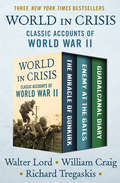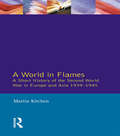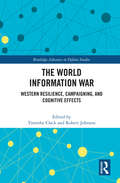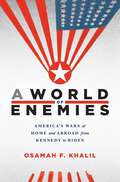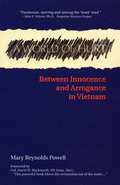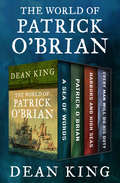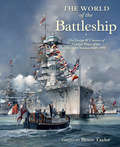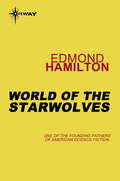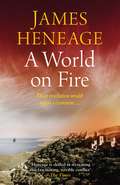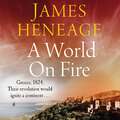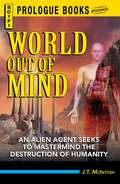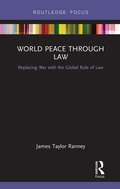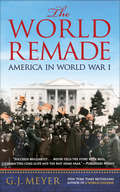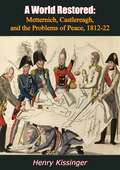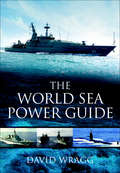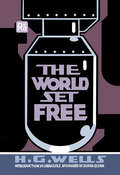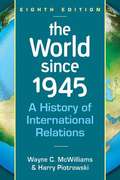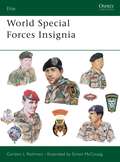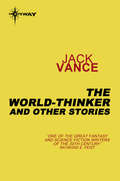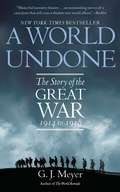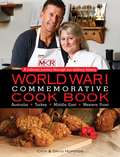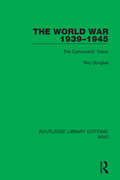- Table View
- List View
World in Crisis: Classic Accounts of World War II
by Richard Tregaskis Walter Lord William CraigThree New York Times–bestselling World War II histories, including the true story of the miraculous evacuation portrayed in the Christopher Nolan film Dunkirk. The monumental scope and breathtaking heroism of World War II are brought to vivid life in three riveting accounts that span the conflict’s Western Front, Eastern Front, and Pacific Theater. The Miracle of Dunkirk: The definitive account of the evacuation of 338,000 British and French soldiers from the beaches of Dunkirk. Based on interviews with hundreds of survivors and masterfully woven together into a cinematic portrait, The Miracle of Dunkirk captures a pivotal moment when the outcome of World War II hung in the balance. “Stunning . . . The difference between the Lord technique and that of any number of academic historians is the originality of his reportage” (The New York Times). Enemy at the Gates: New York Times bestseller and the inspiration for the 2001 film starring Joseph Fiennes and Jude Law. The siege of Stalingrad lasted five months, one week, and three days. Nearly two million men and women died, and Germany’s 6th Army was completely destroyed. Considered by many historians to be the turning point of World War II in Europe, the Soviet Army’s victory foreshadowed Hitler’s downfall and the rise of a communist superpower. Crafted from five years of exhaustive research and interviews with hundreds of survivors, Enemy at the Gates is “probably the best single work on the epic battle of Stalingrad . . . An unforgettable and haunting reading experience” (Cornelius Ryan, author of The Longest Day). Guadalcanal Diary: #1 New York Times bestseller and the basis for the 1943 film starring Anthony Quinn and Richard Conte. Volunteer combat correspondent Richard Tregaskis was one of two journalists to witness the invasion of Guadalcanal, the first major Allied offensive against Japanese forces and the first time in history that a combined air, land, and sea assault had ever been attempted. Hailed by the New York Times as “one of the literary events of its time,” Guadalcanal Diary is “a superb example of war reporting at its best” (Mark Bowden, author of Black Hawk Down).
A World in Flames: A Short History of the Second World War in Europe and Asia 1939-1945
by Martin KitchenA concise account of the war - including the war in Asia and the Pacific as well as the European arena. Covers the formation of the victorious Grand Alliance and to the problems that beset it, and to Nazi Germany's relations with its allies.
The World Information War: Western Resilience, Campaigning, and Cognitive Effects (Routledge Advances in Defence Studies)
by Timothy ClackThis book outlines the threats from information warfare faced by the West and analyses the ways it can defend itself. Existing on a spectrum from communication to indoctrination, information can be used to undermine trust, amplify emotional resonance, and reformulate identities. The West is currently experiencing an information war, and major setbacks have included: ‘fake news’; disinformation campaigns; the manipulation of users of social media; the dissonance of hybrid warfare; and even accusations of ‘state capture’. Nevertheless, the West has begun to comprehend the reality of what is happening, and it is now in a position defend itself. In this volume, scholars, information practitioners, and military professionals define this new war and analyse its shape, scope, and direction. Collectively, they indicate how media policies, including social media, represent a form of information strategy, how information has become the ‘centre of gravity’ of operations, and why the further exploitation of data (by scale and content) by adversaries can be anticipated. For the West, being first with the truth, being skilled in cyber defence, and demonstrating virtuosity in information management are central to resilience and success. This book will be of much interest to students of strategic studies, information warfare, propaganda studies, cyber-security, and International Relations.
A World of Enemies: America’s Wars at Home and Abroad from Kennedy to Biden
by Osamah F. KhalilA sobering account of how the United States trapped itself in endless wars—abroad and at home—and what it might do to break free.Over the past half-century, Americans have watched their country extend its military power to what seemed the very ends of the earth. America’s might is felt on nearly every continent—and even on its own streets. Decades ago, the Wars on Drugs and Terror broke down the walls separating law enforcement from military operations. A World of Enemies tells the story of how an America plagued by fears of waning power and influence embraced foreign and domestic forever wars.Osamah Khalil argues that the militarization of US domestic and foreign affairs was the product of America’s failure in Vietnam. Unsettled by their inability to prevail in Southeast Asia, US leaders increasingly came to see a host of problems as immune to political solutions. Rather, crime, drugs, and terrorism were enemies spawned in “badlands”—whether the Middle East or stateside inner cities. Characterized as sites of endemic violence, badlands lay beyond the pale of civilization, their ostensibly racially and culturally alien inhabitants best handled by force.Yet militarized policy has brought few victories. Its failures—in Iraq, Afghanistan, US cities, and increasingly rural and borderland America—have only served to reinforce fears of weakness. It is time, Khalil argues, for a new approach. Instead of managing never-ending conflicts, we need to reinvest in the tools of traditional politics and diplomacy.
A World of Hurt: Between Innocence and Arrogance in Vietnam
by Mary Reynolds PowellFrom the prologue: What follows is an account of my own experience in Vietnam as well as the stories of seven friends who served with me. Though we came from diverse backgrounds and held different positions in the military, we shared the Vietnam War of 1971.
The World of Patrick O'Brian: A Sea of Words, A Life Revealed, Harbors and High Seas, and Every Man Will Do His Duty
by Dean KingIn these three companion books to Patrick O'Brian's novels, and a biography of the author, Dean King proves himself an authority on maritime writers and their work. What is a sandgrouse, and where does it live? What are the medical properties of lignum vitae, and how did Stephen Maturin use it to repair his viola? Who is Adm. Lord Keith, and why is his wife so friendly with Capt. Jack Aubrey? More than any other contemporary author, Patrick O'Brian knew the past. His twenty Aubrey-Maturin novels, beginning with Master and Commander (1969), are distinguished by deep characterization, heart-stopping naval combat, and an attention to detail that enriches and enlivens his stories. In the revised edition of A Sea of Words, Dean King and his collaborators dive into Jack Aubrey's world. In the revised edition of Harbors and High Seas, King details not just where Aubrey and Maturin went, but how they got there. Packed with maps and illustrations from the greatest age of sail, it is an incomparable reference for devotees of O'Brian's novels and anyone who has dreamed of climbing aboard a warship, as well as a captivating portrait of life on the sea during a time when nothing stood between man and ocean but grit, daring, and a few creaking planks of wood. At the dawn of the nineteenth century, the British navy was the mightiest instrument of war the world had ever known. The Royal Navy patrolled the seas from India to the Caribbean, connecting an empire with footholds in every corner of the earth. Such a massive navy required the service of more than 100,000 men--from officers to deckhands to surgeons. Their stories are collected in Every Man Will Do His Duty. The inspiration for the bestselling novels of Patrick O'Brian and C. S. Forester, these twenty-two memoirs and diaries, edited by Dean King, provide a true portrait of life aboard British warships during one of the most significant eras of world history. Patrick O'Brian was well into his seventies when the world fell in love with his greatest creation: the maritime adventures of Royal Navy Capt. Jack Aubrey and ship's surgeon Stephen Maturin. But despite his fame, little detail was available about the life of the reclusive author, whose mysterious past King uncovers in this groundbreaking biography. King traces O'Brian's personal history from his beginnings as a London-born Protestant named Richard Patrick Russ to his tortured relationship with his first wife and child to his emergence from World War II with the entirely new identity under which he would publish twenty volumes in the Aubrey-Maturin series. What King unearths is a life no less thrilling than the seafaring world of O'Brian's imagination. Patrick O'Brian: A Life Revealed is a penetrating and insightful examination of one of the modern world's most acclaimed historical novelists.
The World of the Battleship: The Design & Careers of Capital Ships of the World's Navies, 1880–1990
by Bruce TaylorThis new volume is intended to present a global vision of the development of the world's battleships. In a collection of chapters by international, the design, building, and career of a significant battleship from each of the world's navies is explored that illuminates not just the ships but also the communities of officers and individuals that served in them and, more broadly, the societies and nations that built them. Each chapter explains the origins of a ship, her importance as a national symbol, and her place in the fleet. This is a highly original and significant book on the great capital ships of the world.
World of the Starwolves
by Edmond HamiltonMorgan Chane returns to Varna to lead the Starwolves to the Galaxy's greatest loot...THE WORLD OF THE STARWOLVES.
A World on Fire
by James HeneageTheir revolution would ignite a continent...An epic novel set during one of the most savage and dramatic moments in European history.Greece, 1824In the wild south, the people of the Mani have risen up against four hundred years of Ottoman rule. But initial triumph leads to bitter feuding among the Greek victors and the Sultan sends his vassal, Ibrahim Pasha of Egypt, to invade. Burning everything in his path, he is on the point of victory. Only the intervention of the Great Powers of France, Russia and Britain can save Greece.Hara, young daughter of a Maniot chief, is the fearless symbol of her people's spirit. When she rescues Greek Prince Tzanis from a shipwreck, on his way to deliver secret gold for the revolution, they fall in love but are forced apart by events.Yet a shared resolve to wreak vengeance on Turkish rule unites them again, and their heroism and sacrifice will ultimately inspire an unlikely band of men and women to join them in rescuing Greece. Will their plan to involve the Great Powers succeed before Greece is destroyed by fire?'Wonderful history, adventure and a heart-breaking love story are brought thrillingly to life' - Kate Mosse
A World on Fire
by James HeneageTheir revolution would ignite a continent...An epic novel set during one of the most savage and dramatic moments in European history.Greece, 1824In the wild south, the people of the Mani have risen up against four hundred years of Ottoman rule. But initial triumph leads to bitter feuding among the Greek victors and the Sultan sends his vassal, Ibrahim Pasha of Egypt, to invade. Burning everything in his path, he is on the point of victory. Only the intervention of the Great Powers of France, Russia and Britain can save Greece.Hara, young daughter of a Maniot chief, is the fearless symbol of her people's spirit. When she rescues Greek Prince Tzanis from a shipwreck, on his way to deliver secret gold for the revolution, they fall in love but are forced apart by events.Yet a shared resolve to wreak vengeance on Turkish rule unites them again, and their heroism and sacrifice will ultimately inspire an unlikely band of men and women to join them in rescuing Greece. Will their plan to involve the Great Powers succeed before Greece is destroyed by fire?'Wonderful history, adventure and a heart-breaking love story are brought thrillingly to life' - Kate Mosse
A World on Fire
by James HeneageTheir revolution would ignite a continent...An epic novel set during one of the most savage and dramatic moments in European history.Greece, 1824In the wild south, the people of the Mani have risen up against four hundred years of Ottoman rule. But initial triumph leads to bitter feuding among the Greek victors and the Sultan sends his vassal, Ibrahim Pasha of Egypt, to invade. Burning everything in his path, he is on the point of victory. Only the intervention of the Great Powers of France, Russia and Britain can save Greece.Hara, young daughter of a Maniot chief, is the fearless symbol of her people's spirit. When she rescues Greek Prince Tzanis from a shipwreck, on his way to deliver secret gold for the revolution, they fall in love but are forced apart by events.Yet a shared resolve to wreak vengeance on Turkish rule unites them again, and their heroism and sacrifice will ultimately inspire an unlikely band of men and women to join them in rescuing Greece. Will their plan to involve the Great Powers succeed before Greece is destroyed by fire?'Wonderful history, adventure and a heart-breaking love story are brought thrillingly to life' - Kate Mosse(P)2018 Quercus Editions Limited
World Out of Mind
by J. T. McintoshThe earth is doomed!Only ten people out of every 3,000 will escape aboard space ships to begin a new colony on Mars. For the rest of humanity . . . inevitable destruction.Bill Easson is a conscientious, straightforward guy. But as pilot of one of the ships, he holds the power of life and death in his hands. As the time grows nearer, violent mobs swarm through the streets, and the ten names on Bill’s list change and change again.The authorities only give Bill a 60 percent chance of survival. He knows in his bones he’s got to lengthen the odds.Or die trying.
World Peace Through Law: Replacing War with the Global Rule of Law
by James Taylor RanneyThis book deals with the history and future of the concept of ‘world peace through law’ (WPTL), which advocates replacing the use of international force with the global rule of law. WPTL calls for replacing war with the global rule of law by arms reductions, including the abolition of nuclear weapons, global alternative dispute resolution mechanisms, and various enforcement mechanisms. This book sets forth a three-part proposal: 1) arms reductions – primarily the abolition of nuclear weapons, with necessarily concomitant reductions in conventional forces; 2) a four-stage system of global alternative dispute resolution (ADR), utilizing both law and equity; 3) adequate enforcement mechanisms, including a UN Peace Force. The core of this proposal is alternative dispute resolution mechanisms—international ADR. International ADR would consist of a four-stage process of compulsory negotiation, compulsory mediation, compulsory arbitration., and compulsory adjudication by the World Court. The fundamental proposition of this book is that the use of alternatives to war, global ADR, is the ultimate solution to the problem of peace. The full implementation of WPTL will entail a vast array of progressive initiatives on many fronts, including abolition of nuclear weapons, with the global rule of law being the capstone to all of these developments. This book will be of great interest to students of peace studies, arms control, international law, and world politics.
The World Remade: America in World War I
by G. J. MeyerA bracing, indispensable account of America’s epoch-defining involvement in the Great War, rich with fresh insights into the key issues, events, and personalities of the period After years of bitter debate, the United States declared war on Imperial Germany on April 6, 1917, plunging the country into the savage European conflict that would redraw the map of the continent—and the globe. The World Remade is an engrossing chronicle of America’s pivotal, still controversial intervention into World War I, encompassing the tumultuous politics and towering historical figures that defined the era and forged the future. When it declared war, the United States was the youngest of the major powers and militarily the weakest by far. On November 11, 1918, when the fighting stopped, it was not only the richest country on earth but the mightiest. With the mercurial, autocratic President Woodrow Wilson as a primary focus, G. J. Meyer takes readers from the heated deliberations over U.S. involvement, through the provocations and manipulations that drew us into the fight, to the battlefield itself and the shattering aftermath of the struggle. America’s entry into the Great War helped make possible the defeat of Germany that had eluded Britain, France, Russia, and Italy in three and a half years of horrendous carnage. Victory, in turn, led to a peace treaty so ill-conceived, so vindictive, that the world was put on the road to an even bloodier confrontation a mere twenty years later. On the home front, Meyer recounts the break-up of traditional class structures, the rise of the progressive and labor movements, the wave of anti-German hysteria, and the explosive expansion of both the economy and federal power, including shocking suspensions of constitutional protections that planted the seeds of today’s national security state. Here also are revealing portraits of Theodore Roosevelt, Henry Cabot Lodge, Robert La Follette, Eugene Debs, and John J. “Black Jack” Pershing, among others, as well as European leaders such as “Welsh Wizard” David Lloyd George of Britain, “Tiger” Georges Clemenceau of France, and Kaiser Wilhelm II of Germany. Meyer interweaves the many strands of his story into a gripping narrative that casts new light on one of the darkest, most forgotten corners of U.S. history. In the grand tradition of his earlier work A World Undone—which centered on the European perspective—The World Remade adds a new, uniquely American dimension to our understanding of the seminal conflict of the twentieth century.
A World Restored: Metternich, Castlereagh, and the Problems of Peace, 1812-22 (Weidenfeld And Nicolson 50 Years Ser.)
by Henry KissingerOriginally published in 1957—years before he was Secretary of State and winner of the Nobel Peace Prize—, Henry Kissinger wrote A World Restored, to understand and explain one of history’s most important and dramatic periods; a time when Europe went from political chaos to a balanced peace that lasted for almost a hundred years.After the fall of Napoleon, European diplomats gathered in a festive Vienna with the task of restoring stability following the French Revolution, the Napoleonic Wars, and the dissolution of the Holy Roman Empire. The central figures at the Congress of Vienna were the Foreign Secretary of the United Kingdom, Viscount Castlereagh and the Foreign Minister of Austria Klemens Wenzel von Mettern Metternich. Castlereagh was primarily concerned with maintaining balanced powers, while Metternich based his diplomacy on the idea of legitimacy—that is, establishing and working with governments that citizens accept without force. The peace they brokered lasted until the outbreak of World War I.Through trenchant analysis of the history and forces that create stability, A World Restored gives insight into how to create long-lasting geopolitical peace-lessons that Kissinger saw as applicable to the period immediately following World War II, when he was writing this book.But the lessons don’t stop there. Like all good insights, the book’s wisdom transcends any single political period. Kissinger’s understanding of coalitions and balance of power can be applied to personal and professional situations, such as dealing with a tyrannical boss or co-worker or formulating business or organizational tactics.Regardless of his ideology, Henry Kissinger has had an important impact on modern politics and few would dispute his brilliance as a strategist. For anyone interested in Western history, the tactics of diplomacy, or political strategy, this volume will provide deep understanding of a pivotal time.
The World Sea Power Guide
by David WraggCompiled by the author of Janes Air Forces of the World, this book is a must for naval experts and enthusiasts. In one volume the reader will find the composition and details of all naval elements of a staggering 137 nations armed forces including paramilitary organizations as the US Coast Guard Service. The book starts with an introduction based on the situation today and the response of the leading maritime powers. This is an interesting period with considerable uncertainty for the Royal Navy following the Strategic Defense Review. Many other countries, including Australia and Spain are boosting their naval strength to achieve strategic reach, while piracy has become a major problem in at least four different areas of the world. In each case, the history is followed by details of current fleet sizes, composition and deployments.
The World Set Free: Perfect Gifts For The Readers Annotated By H. G. Wells (MIT Press / Radium Age)
by H. G. WellsIn a novel written on the eve of World War I, H. G. Wells imagines a war &“to end all wars&” that begins in atomic apocalypse but ends in an enlightened utopia.Writing in 1913, on the eve of World War I&’s mass slaughter and long before World War II&’s mushroom cloud finale, H. G. Wells imagined a war that begins in atomic apocalypse but ends in a utopia of enlightened world government. Set in the 1950s, Wells&’s neglected novel The World Set Free describes a conflict so horrific that it actually is the war that ends war. Wells—the first to imagine a &“uranium-based bomb&”—offers a prescient description of atomic warfare that renders cities unlivable for years: &“Whole blocks of buildings were alight and burning fiercely, the trembling, ragged flames looking pale and ghastly and attenuated in comparison with the full-bodied crimson glare beyond.&” Drawing on discoveries by physicists and chemists of the time, Wells foresees both a world powered by clean, plentiful atomic energy—and the destructive force of the neutron chain reaction. With a cast of characters including Marcus Karenin, the moral center of the narrative; Firmin, a proto-Brexiteer; and Egbert, the visionary young British monarch, Wells dramatizes a world struggling for sanity. Wells&’s supposedly happy ending—a planetary government presided over by European men—may not appeal to contemporary readers, but his anguish at the world&’s self-destructive tendencies will strike a chord. Sarah Cole is the author of Inventing Tomorrow: H.G. Wells and The Twentieth Century (2019). The Parr Professor of English and Comparative Literature and Dean of Humanities at Columbia University, she is the cofounder of the NYNJ Modernism Seminar and founder of the Humanities War and Peace Initiative at Columbia. She is also the author of Modernism, Male Friendship, and the First World War (2003) and At the Violet Hour: Modernism and Violence in England and Ireland (2012). Joshua Glenn, who was the first to describe the years 1900–1935 as science fiction&’s &“Radium Age,&” has helped popularize stories from the era for over a decade now. A former Boston Globe staffer and publisher of the indie intellectual journal Hermenaut, he is coauthor of The Idler&’s Glossary (2008), Significant Objects (2012), and the family activities guide UNBORED (2012). He is also cofounder of the brand consultancy Semiovox; and he publishes the blogHiLobrow.
The World Since 1945: A History Of International Relations
by Wayne C. McWilliams Harry PiotrowskiNew emphasis on the impacts of globalization, events in the Middle East, and political and economic changes in East Asia - as well as new information and maps throughout - are among the features of this thoroughly revised edition. The text traces the political, economic, and ideological patterns that have evolved in the global arena from the end of World War II to the present, providing the background needed for a solid understanding of contemporary international relations.
World Special Forces Insignia
by Simon Mccouaig Gordon RottmanThere exists among the world's armies a proliferation of special forces groups. Today's smaller armies, especially those of developing nations, demand maximum efficiency in force structure and employment. Mountain, jungle, arctic and desert areas require special purpose units trained, conditioned, and equipped to master these environments. This volume by ex-weapons specialist in the US 7th Special Forces Group, Gordon L. Rottman, details the insignia of a myriad of special forces groups from all parts of the globe, from Portugal's Commando Regiment to the North Yemen 'Al Mithalaat' Brigade, with a wealth of illustrations and photographs, including 12 full page colour plates by Simon McCouaig.
The World-Thinker and Other Stories
by Jack VanceThis volume includes Vance's first published story ("The World-Thinker") and a selection of other stories including the novella "Telek".Contents: The World-Thinker, Dream Castle ("I'll Build Your Dream Castle"), Seven Exits from Bocz, The God and the Temple Robber ("The Temple of Han"), Telek, Men of The Ten Books, D.P., Noise ("Music of the Spheres"), The Absent Minded Professor ("First Star I See Tonight"; "Murder Observed"), The Devil On Salvation Bluff, Where Hesperus Falls, The Phantom Milkman, A Practical Man's Guide, The House Lords, The SecretAll Jack Vance titles in the SFGateway use the author's preferred texts, as restored for the Vance Integral Edition (VIE), an extensive project masterminded by an international online community of Vance's admirers. In general, we also use the VIE titles, and have adopted the arrangement of short story collections to eliminate overlaps.
A World Undone: The Story Of The Great War, 1914 To 1918
by G. J. MeyerThe First World War is one of history's greatest tragedies. In this remarkable and intimate account, author G. J. Meyer draws on exhaustive research to bring to life the story of how the Great War reduced Europe's mightiest empires to rubble, killed twenty million people, and cracked the foundations of the world we live in today.
World War 1 Commemorative Cook Book: A Culinary Journey Through Our Military History
by Captain David Hopgood Cath HopgoodMore than just a cookbook! This is a culinary journey through the period when the Anzac legend was born. This cook book showcases the hearty style of cooking evocative of the time, and presents simple, traditional recipes with a modern twist. Featuring a combination of classics like Anzac Biscuits, Turkish Delight and Osso Bucco Potato Pie together with appealing recipes like ‘Roo Tail Stew and Herb Damper and Harissa Spiced Lamb Backstrap Salad, this is a collection of delicious recipes influenced by the era and wartime locations of the Great War. Combined with a brief history of the contributions of the Anzacs, this cook book commemorates and honours our WWI soldiers.
The World War 1939–1945: The Cartoonists' Vision (Routledge Library Editions: WW2 #47)
by Roy DouglasThis new approach to the history of the Second World War, first published in 1990, examines the events of this period through the cartoons of the day. Roy Douglas explains the messages behind the humour and reveals that the perception of war differed radically from country to country. This collection highlights the importance of the media in this global war. ‘An authoritative narrative about what inspired the artists to take to their pens and papers… By putting it all into perspective, the poignancy, and often the brilliance of the political cartoonist is shown to the reader… Douglas’s historical narrative adds to the enjoyment.’ West Coast Review of Books ‘Douglas’s valuable book uses the political cartoon as historical mirror… The book is very important for its attempt to correlate visual media with national policy at a crucial period in recent history.’ Choice
